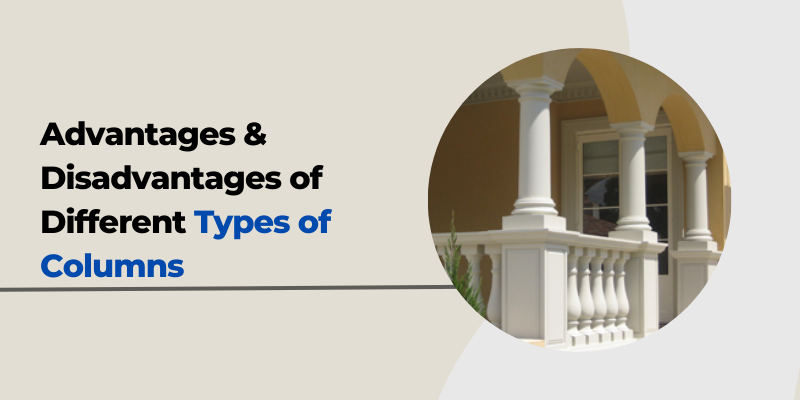Structural columns are the backbone of any building, providing stability and support. Types of columns available have their distinct characteristics, strengths, and weaknesses. Here, we’ll explore the advantages and disadvantages of different structural columns—concrete, steel, wood, and composite materials. Whether designing a building or a smaller project, understanding these options is vital for making the right choice.
I. Concrete Columns: Strong and Durable
Concrete columns are among the most commonly used types in construction – thanks to their strength and longevity. They are a go-to option in many architectural projects, including those in Sydney, because they can handle heavy loads and withstand external pressures such as harsh weather conditions.
Advantages of Concrete Columns
- Concrete has excellent compressive strength, which allows it to support heavy structures.
- It’s ideal for tall buildings or other constructions requiring robust load-bearing elements.
- Concrete columns also provide excellent fire resistance, moisture protection, and the ability to last in harsh environments, whether inside or outside the property.
Disadvantages of Concrete Columns
- Concrete needs time to cure and set properly, which can prolong the construction timeline, leading to slower project completion.
- Concrete columns can be heavier, making transportation and installation tricky, especially in small or elevated areas.
- The weight can complicate projects requiring delicate handling or specific size constraints.
Despite these challenges, concrete columns remain a favourite for many engineers due to their reliable performance and longevity.
II. Steel Columns: Lightweight and Flexible
Steel columns offer unique advantages, especially when flexibility and strength are required. Steel is extensively used in many large-scale projects, such as bridges or expansive open areas within buildings. Its use is becoming more common in modern architectural designs across Sydney due to its ability to create sleek, open spaces.
Advantages of Steel Columns
- One key benefit of steel columns is their high strength-to-weight ratio. Steel is much lighter than concrete yet strong enough to handle significant weight without bending or warping.
- It is ideal for structures spanning wide spaces, such as warehouses or arenas.
- Steel can be shaped, allowing architects to tailor the column to their design goals.
Disadvantages of Steel Columns
- The most significant issue with steel is its susceptibility to corrosion, especially in coastal or humid environments.
- Proper maintenance, including protective coatings and regular inspections, is essential to ensure the longevity of steel columns.
- Steel columns are more expensive than their concrete counterparts; their prices fluctuate based on market conditions. Hence, when opting for steel, budget planning becomes critical.
III. Wood Columns: Cost-Effective and Natural
Wood columns are the type of structural material used in many projects today. They offer a natural, environmentally friendly option that can be highly effective for certain types of buildings like residential and smaller structures.
Advantages of Wood Columns
- Wood is known for being an affordable and accessible building material. Wood is much less expensive than steel or concrete, making it a solid choice for budget-conscious projects.
- It also provides excellent natural insulation, helping buildings stay warmer in winter and cooler in summer.
- Wood can be a fantastic option for projects needing enhanced energy efficiency.
Disadvantages of Wood Columns
- Untreated or poorly maintained wood is susceptible to termite infestations and decay.
- Wood also has lower compressive strength than concrete or steel, so it is less suitable for supporting heavier loads or use in high-rise buildings.
- Over time, wood columns may lose structural integrity if not cared for properly.
IV. Composite Columns: Combining Strengths
Composite columns often blend concrete and steel to create a more optimised structural element. These columns combine the best of each material, offering a blend of strength, flexibility, and durability.
Advantages of Composite Columns
- Composite columns are often lighter than pure concrete and offer greater strength than wood or steel.
- The combination of materials allows engineers to tailor the column to specific project needs, ensuring that the most appropriate material is used where needed.
- In Sydney, where architectural columns must meet stringent design and safety standards, composite columns are gaining popularity.
Disadvantages of Composite Columns
As such, composite columns have no apparent shortcomings, but they face one challenge because of their more complex construction process. Combining materials requires skilled labour and precise engineering, which can increase overall costs.
While the benefits are clear for strength and flexibility, the higher costs and technical expertise needed may make these columns less practical for smaller projects or those on tight budgets.
Final Thoughts
The type of structural column you choose depends on the needs of your project, budget, and the environmental conditions it will face. Concrete columns provide incredible strength and durability. Steel offers flexibility and lightness. Wood is affordable and sustainable. Composite columns incorporate the strengths of both steel and concrete.
Whether dealing with architectural columns in Sydney or anywhere else, understanding their strengths and weaknesses can help ensure the success of your project. By carefully weighing the pros and cons of each column type, architects and engineers can make informed decisions that meet both design and functional requirements.















